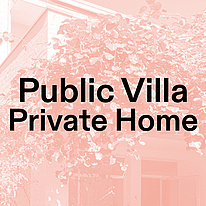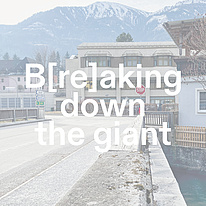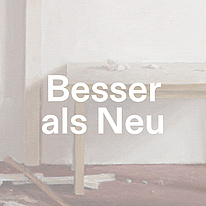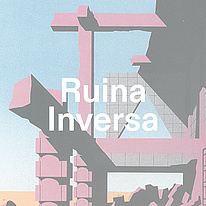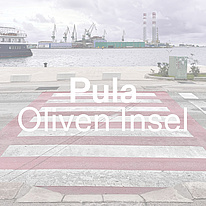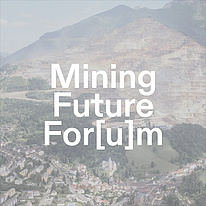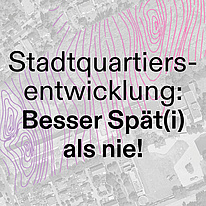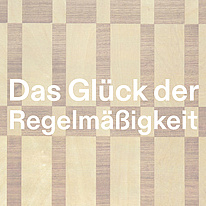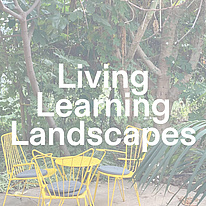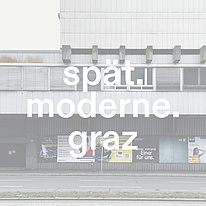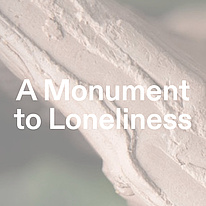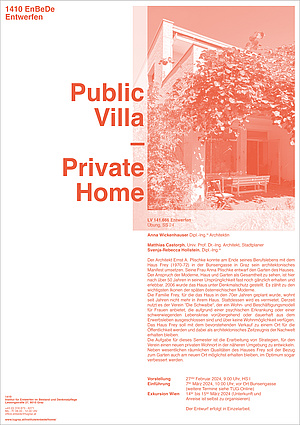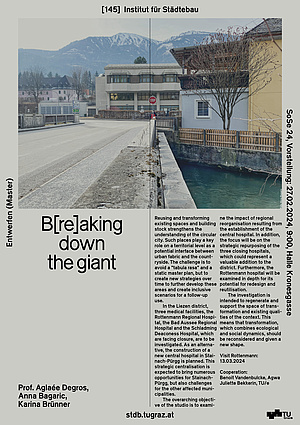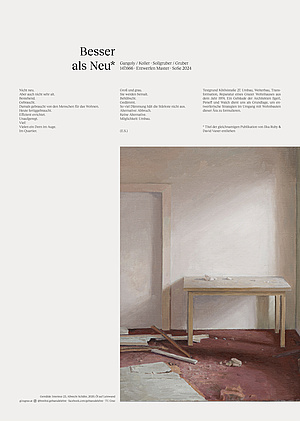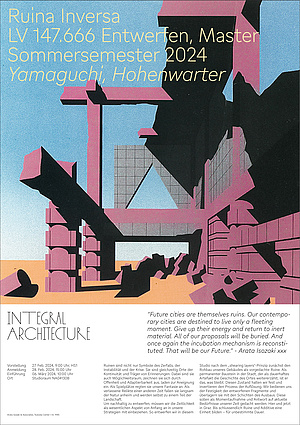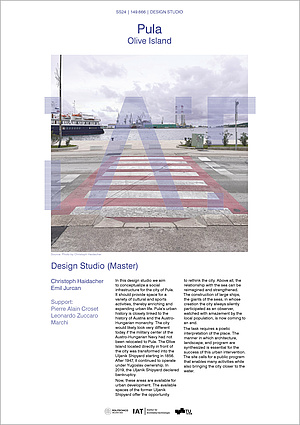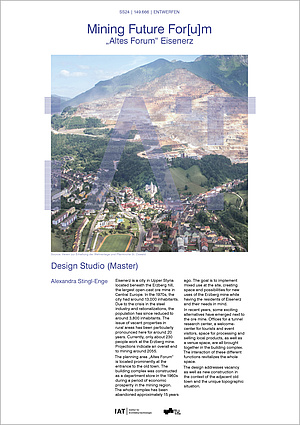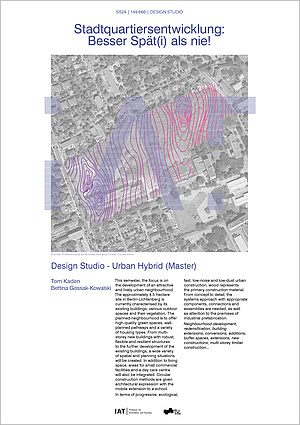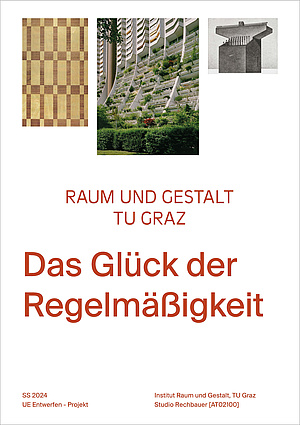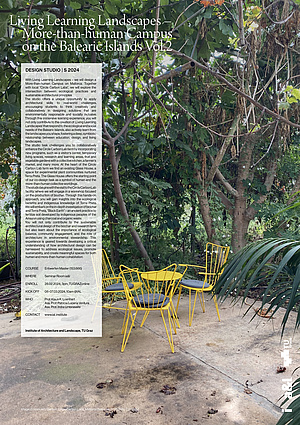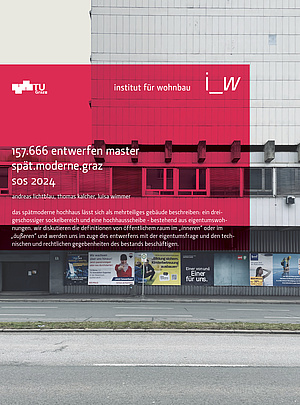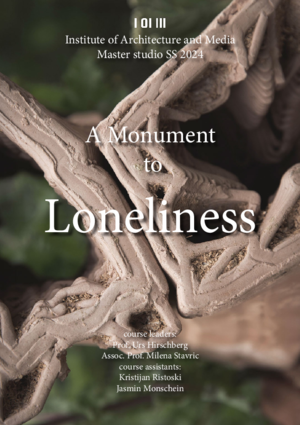141.666 | Public Villa. Private Home
Concept and Direction | Matthias Castorph,
Svenja-Rebecca Hollstein, Anna Wickenhauser
Der Architekt Ernst A. Plischke konnte am Ende seines Berufslebens mit dem Haus Frey (1970-72) in der Bunsengasse in Graz sein architektonisches Manifest umsetzen. Seine Frau Anna Plischke entwarf den Garten des Hauses. Der Anspruch der Moderne, Haus und Garten als Gesamtheit zu sehen, ist hier nach über 50 Jahren in seiner Ursprünglichkeit fast noch gänzlich erhalten und erlebbar. 2006 wurde das Haus unter Denkmalschutz gestellt. Es zählt zu den wichtigsten Ikonen der späten österreichischen Moderne.
Die Familie Frey, für die das Haus in den 70er Jahren geplant wurde, wohnt seit Jahren nicht mehr in ihrem Haus. Stattdessen wird es vermietet. Derzeit nutzt es der Verein “Die Schwalbe“, der ein Wohn- und Beschäftigungsmodell für Frauen anbietet, die aufgrund einer psychischen Erkrankung oder einer schwerwiegenden Lebenskrise vorübergehend oder dauerhaft aus dem Erwerbsleben ausgeschlossen sind und über keine Wohnmöglichkeit verfügen.
Das Haus Frey soll mit dem bevorstehenden Verkauf zu einem Ort für die Öffentlichkeit werden und dabei als architektonisches Zeitzeugnis der Nachwelt erhalten bleiben. Die Aufgabe für dieses Semester ist die Erarbeitung von Strategien, für den Verein einen neuen privaten Wohnort in der näheren Umgebung zu entwickeln. Neben wesentlichen räumlichen Qualitäten des Hauses Frey soll der Bezug zum Garten auch am neuen Ort möglichst erhalten bleiben, im Optimum sogar verbessert werden.
145.666 | B[re]aking down the giant
Concept and Direction | Aglaée Degros,
Anna Bagarić, Karina Brünner
Reusing and transforming existing spaces and building stock strengthens the understanding of the circular approach. Such places play a key role on a territorial level as a potential interface between urban fragments and the countryside. The challenge here is to avoid a "tabula rasa" and a static master plan, but to create new strategies over time to further develop these areas and create inclusive scenarios for a follow-up use phase - such as the intensification of uses and landscapes; updating residential neighbourhoods; reinforcing existing dynamics; new relationships between built and unbuilt environments.
Three medical facilities in the Liezen district, the Rottenmann Regional Hospital, the Bad Aussee Regional Hospital and the Schladming Deaconess Hospital, which are facing closure, are to be investigated. As an alternative, the construction of a new central hospital in Stainach-Pürgg is planned. This strategic centralisation is expected to bring numerous opportunities for Stainach-Pürgg, but also challenges for the other affected municipalities.
The overarching objective of the studio is to examine the impact of regional reorganisation resulting from the establishment of the central hospital. In addition, the focus will be on the strategic repurposing of the three closing hospitals, which could represent a valuable addition to the district. Furthermore, the Rottenmann hospital will be examined in depth for its potential for redesign and reutilisation. The investigation is intended to regenerate and support the space of transformation and existing qualities of the context. This means that transformation, which combines ecological and social dynamics, should be reconsidered and given a new shape.
147.666 | tba
Concept and Direction | Hans Gangoly,
Tobias Gruber, Elisabeth Koller,
Eva Sollgruber
Nicht neu.
Aber auch nicht sehr alt.
Bestehend.
Gebraucht.
Damals gebraucht von den Menschen für das Wohnen.
Heute fertiggebraucht.
Effizient errichtet.
Unaufgeregt.
Viel!
Vielen ein Dorn im Auge.
Im Quartier.
Groß und grau.
Sie werden bemalt.
Behübscht.
Gedämmt.
So viel Dämmung hält die Stärkste nicht aus.
Alternative: Abbruch.
Keine Alternative.
Möglichkeit: Umbau.
(E.S.)
Testgrund Körösistaße 27. Umbau, Weiterbau, Transformation, Reparatur eines Grazer Wohnhauses aus dem Jahr 1974. Ein Gebäude der Architekten Ilgerl, Peneff und Walch dient uns als Grundlage, um entwerferische Strategien im Umgang mit Wohnbauten dieser Ära zu formulieren.
* Titel der gleichnamigen Publikation von Ilka Ruby & David Vaner entliehen
Link to course
Link to institute website
147.666 | Ruina Inversa
Concept and Direction |
Lisa Yamaguchi, Katharina Hohenwartner
Ruins are not only symbols of decay, instability and crisis. They are simultaneously places of continuity and carriers of memories. Moreover, they are also spaces of possibility, characterised by openness and adaptability, inviting appropriation. As playgrounds, they stimulate our imagination. As abandoned relics of another time, they slowly revert to nature and become part of the landscape themselves.
In order to design sustainably, we need to include temporality as an essential aspect in our strategies from the outset. In this studio, we therefore initially design the shell of our building as a preconceived ruin according to the "shearing layers" principle. As a permanent element in the city which continues to tell the history of the place as a lasting artefact, it is what remains. We capture this state and invert the process of dissolution. We utilise the solidity of the designed fragments and superimpose them with the layers of the extension. These are intended as a snapshot and response to the current demands of our time. Here and now in Graz. Until ultimately ruin and additive form a whole - for an indefinite period of time.
149.666 | Pula. Olive Island
Concept and Direction |
Christoph Haidacher, Emil Jurcan
In this design studio we aim to conceptualize a social infrastructure for the city of Pula. It should provide space for a variety of cultural and sports activities, thereby enriching and expanding urban life. Pula‘s urban history is closely linked to the history of Austria and the Austro- Hungarian monarchy. The city would likely look very different today if the military center of the Austro-Hungarian Navy had not been relocated to Pula. The Olive Island located directly in front of the city was transformed into the Uljanik Shipyard starting in 1856. After 1947, it continued to operate under Yugoslav ownership. In 2019, the Uljanik Shipyard declared bankruptcy.
Now, these areas are available for urban development. The available spaces of the former Uljanik Shipyard offer the opportunity to rethink the city. Above all, the relationship with the sea can be reimagined and strengthened. The construction of large ships, the giants of the seas, in whose creation the city always silently participated as an observer, watched with amazement by the local population, is now coming to an end.
The task requires a poetic interpretation of the place. The manner in which architecture, landscape, and program are synthesized is essential for the success of this urban intervention. The site calls for a public program that enables many activities while also bringing the city closer to the water.
149.666 | Mining Future For[u]m. "Altes Forum" Eisenerz
Concept and Direction |
Alexandra Stingl-Enge
Eisenerz is a city in Upper Styria located beneath the Erzberg hill, the largest open-cast ore mine in Central Europe. In the 1970s, the city had around 13,000 inhabitants. Due to the crisis in the steel industry and rationalizations, the population has since reduced to around 3,800 inhabitants. The issue of vacant properties in rural areas has been particularly pronounced here for around 20 years. Currently, only about 230 people work at the Erzberg mine. Projections indicate an overall end to mining around 2055.
The planning area „Altes Forum“ is located prominently at the entrance to the old town. The building complex was constructed as a department store in the 1960s during a period of economic prosperity in the mining region. The whole complex has been abandoned approximately 15 years ago. The goal is to implement mixed use at the site, creating space and possibilities for new uses of the Erzberg mine while having the residents of Eisenerz and their needs in mind.
In recent years, some exciting alternatives have emerged next to the ore mine. Offices for a tunnel research center, a welcomecenter for tourists and event visitors, space for processing and selling local products, as well as a venue space, are all brought together in the building complex. The interaction of these different functions revitalizes the whole space.
The design addresses vacancy as well as new construction in the context of the adjacent old town and the unique topographic situation.
149.666 | Stadtquartiersentwicklung: Besser Spät(i) als nie!
Concept and Direction | Tom Kaden,
Bettina Gossak-Kowalski
This semester, the focus is on the development of an attractive and lively urban neighbourhood. The approximately 4.5-hectare site in Berlin-Lichtenberg is currently characterised by its existing buildings, various outdoor spaces and their vegetation. The planned neighbourhood is to offer high-quality green spaces, wellplanned pathways and a variety of housing types. From multistorey new buildings with robust, flexible and resilient structures to the further development of the existing buildings, a wide variety of spatial and planning situations will be created. In addition to living space, areas for small commercial facilities and a day care centre will also be integrated. Circular construction methods are given architectural expression with the mobile extension to a school.
In terms of progressive, ecological, fast, low-noise and low-dust urban construction, wood represents the primary construction material. From concept to detail, the systems approach with appropriate components, connections and assemblies are needed, as well as attention to the premises of industrial prefabrication.
Neighbourhood development, redensification, building extensions, conversions, additions, buffer spaces, extensions, new constructions, multi-storey timber construction...
Link to course
Link to institute website
151.666 | Das Glück der Regelmäßigkeit
Concept and Direction | Alex Lehnerer,
Franziska Hederer, Klemen Breitfuss
Instead of viewing abstract order as the antagonist of the figurative, as discussed at length in the late modernism of the last century, we want to ask about the figurative quality within sequence, repetition and tectonic order of architecture. In this we find the happiness of regularity; between figure, repetition, object, rhythm, the house, the object and back to the architectural figure. When does a house, an object (properly) begin to flicker and lose its legible form?
The work of artists such as Konrad Klapheck, Thomas Huber or Thomas Schütte will help us to create buildings from the ordinary, to lead them from their representation to a covert rhetorical power. To a house, better than its reference. In the process, its form and content lose their functional ties - houses develop for living, offices, why not a prison, a hospital, a hotel, perhaps even a parking garage or a supermarket. Typologically, if at all, more like a cheese grater or a typewriter than a tower or a block. Naturally, in Graz.
153.666 | Living Learning Landscapes. More-than-human Campus on the Balearic Islands Vol.2
Concept and Direction | Klaus K. Loenhart,
Patricia Lucena Ventura, Indre Umbrasaite
With Living Learning Landscapes – we will design a More-than-human Campus on Mallorca. Together with local “Circle Carbon Labs“, we will explore the intersection between ecological practices and sustainable architectural principles. This studio provides a unique opportunity for students to apply their architectural skills to environmental and social challenges, promoting creative, collaborative designs that are environmentally and socially conscious. Participants will engage in creating 'Living Learning Landscapes' that meet the Balearic Islands' ecological and social demands, learning from the landscapes they help shape. The studio involves enhancing Circle Carbon Lab's farm with new facilities like a visitor center, living spaces, and educational areas, centered around an existing Glass House for experimental plant communities. The course starts with a biochar production workshop at Circle Carbon Lab, on Mallorca, teaching the production process and ecological and cultural significance of Terra Preta. Students will contribute to the farm's sustainable design while learning about ecological balance, community engagement, and the architectural role in environmental stewardship, fostering a comprehensive understanding of architecture's potential to address ecological challenges and enhance human and more-than-human coexistence.
157.666 | spät.moderne.graz
Concept and Direction | Andreas Lichtblau,
Thomas Kalcher, Luisa Wimmer
the late modern high-rise can be described as a multi-part building: a three-storey base area and a high-rise slice - consisting of condominiums. we discuss the definitions of public space in the indoors or outdoors and will deal with the question of ownership and the technical and regulatory conditions of the existing building in the process of designing.
Link to course
Link to institute website
161.666 | A Monument to Loneliness
Concept and Direction | Urs Hirschberg,
Milena Stavrić
This is a studio about loneliness. Loneliness is an emotion, a state, a frequently discussed condition in the modern world. A growing number of people suffer from loneliness and isolation. It is a serious problem in many societies. Britain famously created a ministry of loneliness in 2018 to address the growing threat to its population. In 2023 the World Health Organisation (WHO) made loneliness a global health priority with a new commission on social connection. Paradoxically, loneliness is also something we sometimes do not get enough of in today’s connected world. Loneliness allows for introspection and contemplation. For many creative pursuits and types of learning we need to be alone and undisturbed.
This studio project invites students to explore loneliness as a complex and multifaceted phenomenon and to design and build a monument for it: A Monument to Loneliness.
A monument is a structure that is created to commemorate something, usually a person or an event. Monuments also have the power to inspire us, to remind us of our shared humanity and the values that bind us together as a society. According to Adolf Loos, the monument is one of the most essential and most challenging architectural tasks. To make the challenge less daunting, we have already made certain decisions about how we will develop our monument to loneliness

